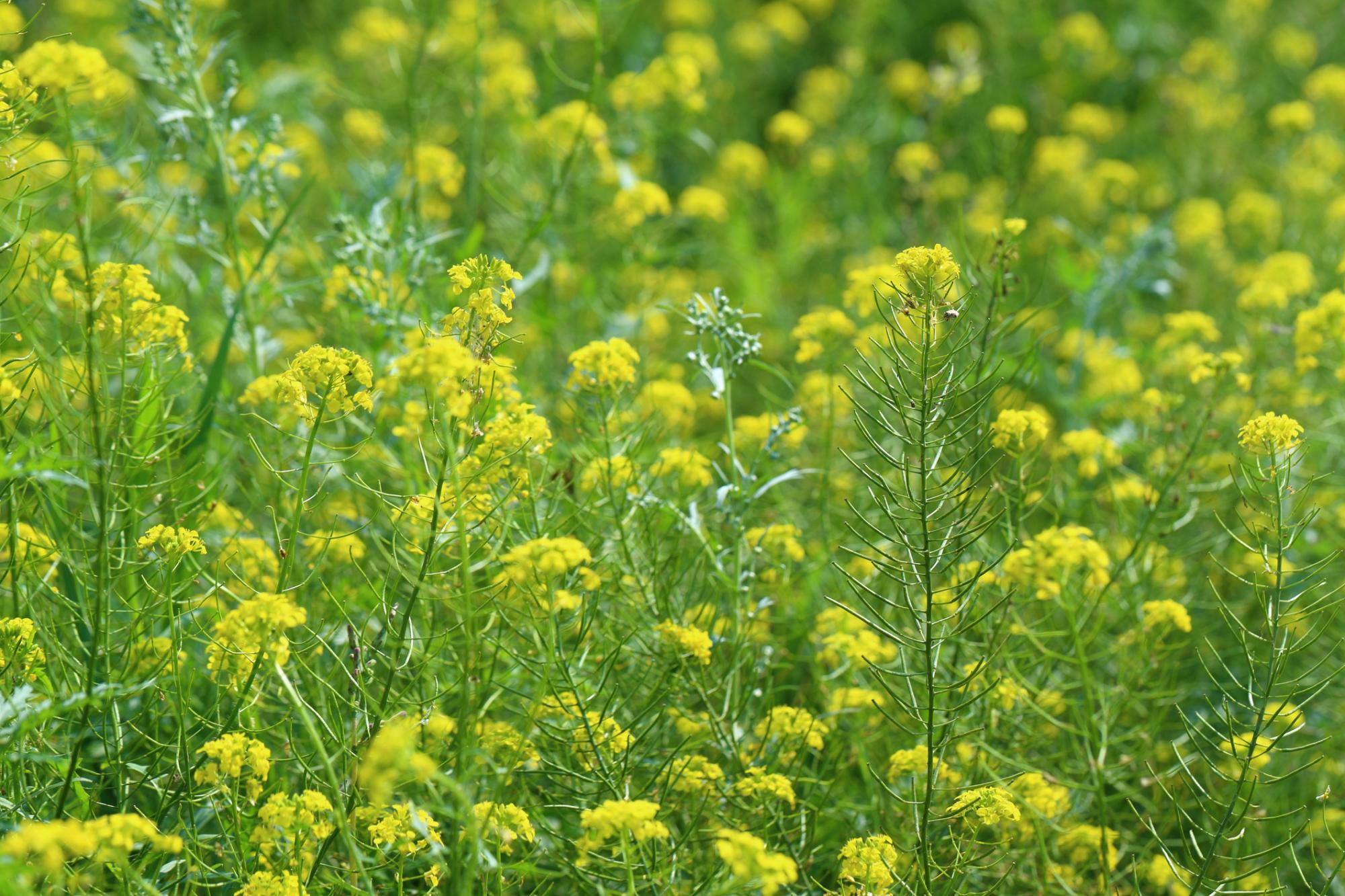Pests, Diseases and Weed Management of Mustard
The common diseases and pests of White Mustard are given below:
Pests
Flea beetles (Phyllotreta spp): Young plants are particularly susceptible to flea beetle infestations, especially in regions where they are a prevalent issue. These tiny pests create small holes or pits in the leaves of the plants, which can significantly damage their overall health. To protect your crops from flea beetles, several measures can be taken:
- Mulching: Applying mulch around the base of the plants can provide a physical barrier and reduce the chances of flea beetles reaching the leaves.
- Trap Crops: Planting trap crops that attract flea beetles away from your main crop can help protect your valuable plants.
- Insecticides: Consider using insecticides specifically designed to control flea beetles, but do so in accordance with recommended guidelines and precautions.
Cabbage Aphids (Brevicoryne brassicaea): Cabbage aphids mainly feed on cruciferous plants, however, they can also survive on similar weed species. Large populations can kill the plants. They can be seen easily on the leaves and the plants show stunted growth. They can be prevented by using:
- Reflective Mulches: Using reflective mulches in your fields can disorient aphids and reduce their ability to locate host plants.
- Resistant Varieties: Consider planting cabbage varieties that are less susceptible to aphid infestations.
- Insecticides: If you are dealing with a significant infestation, you may need to use insecticides to control cabbage aphids, following recommended application procedures.
Whitefly: Whiteflies are tiny insects that feed on plant sap and produce a sticky substance called honeydew, which attracts black sooty mold. This can lead to yellowing and wilting of leaves. To prevent whitefly infestations:
- Insecticides: Apply insecticides that are effective against whiteflies when necessary, adhering to proper usage guidelines.
- Resistant Varieties: Choose plant varieties that have natural resistance to whiteflies.
Cabbage Root Maggot(Delia radicum): Cabbage root maggots lay their eggs in the roots of plants, and their larvae tunnel into the roots, causing wilting even when the plants have sufficient water. To prevent and manage cabbage root maggot infestations: Floating Row Covers: Use floating row covers to prevent adult flies from laying their eggs on the plant roots.
- Mulch: Mulching around the base of your plants can create a physical barrier that discourages egg-laying and encourages natural predators like ground beetles.
- Yellow Trap Cards: Place yellow trap cards in your fields to capture adult flies and reduce their population.
Diamondback Moth (Plutella xylostell): The larvae of diamondback moths feed on various parts of cruciferous plants, including leaves, flowers, and stems. They can strip the leaves down to the veins if the population is large. To manage diamondback moths:
- Natural Enemies: Νatural predators like Entomophthorales fungi, damsel bugs, and certain ground bugs.
- Cold Weather: Diamondback moths are susceptible to cold weather, which can kill them before they can lay eggs.
- Insecticides: If the infestation becomes severe, consider using insecticides following recommended guidelines.
Diseases
Sclerotinia stem rot (White mold) Sclerotinia sclerotiorum: Sclerotinia stem rot is a fungal disease characterized by irregular, necrotic gray lesions on leaves and white-gray lesions on stems. It can also lead to decreased pod set and the breaking of seed pods. To prevent and manage Sclerotinia stem rot you can apply foliar fungicides, remove debris, and use resistant varieties.
Downy mildew (Peronospora parasitica): Downy mildew is a fungal disease that causes grayish-white irregular necrotic spots on the leaves lower surface. To prevent and manage downy mildew: It can be prevented by debris removal, rotation with non-brassicas, and application of fungicides if disease symptoms are evident.
White rust (Albugo candida): White rust, caused by a fungus, is identified by white creamy yellow elevated pustules on the leaves that eventually consolidate into patches. To prevent and manage white rust: It can be prevented by rotating crops; and planting disease-resistant seeds and, if disease becomes an issue, we can use a suitable fungicide.
White leaf spot (Mycospaerella capsellae): White leaf spot, another fungal disease, results in white to gray leaf spots that may give the plant an overall gray appearance. It can be prevented by cultural practices such as crop rotation and debris cleaning because there is no resistant variety for this disease but the application of suitable fungicide can help.
Mosaic virus (Turnip mosaic virus): Mosaic virus is characterized by irregular green and yellow patches on the leaves. It can be prevented by changing the timing of sowing to avoid maximum aphid activity. Reflective mulches may stop aphids from attacking crops. Application of appropriate insecticides may help in the suppression of secondary viral spread, but it will not benefit plants that are already infected.
Alternaria Blight: Alternaria blight is a seed-borne disease caused by the fungus Alternaria brassicae. It attacks lower leaves, leaving causes brown or black necrotic spots on the leaves that slowly increase in size and can also affect the pods. Always remove the debris of the affected plant because its spores survive in the debris of the diseased plant
To prevent white mustard pests and diseases, good cultural techniques such as crop rotation, correct irrigation, and nutrient levels must be followed. Furthermore, biological controls and organic insecticides can be beneficial in pest and disease management. White mustard growers may ensure a healthy and successful harvest by being proactive and employing management measures.
White Mustard Weed Management
We can achieve weed control in White mustard by combining cultural, mechanical, and chemical control techniques. Here are some methods for controlling weeds in white mustard:
Cultural practices
Crop Rotation: We can disturb weeds’ life cycles by rotating mustard crops with other crops. Doing this will help in the reduction of weed pressure.
Planting density: We can avoid weeds by planting white mustard at the prescribed spacing and density. Doing this can promote rapid canopy closure and suppress weed growth. The vigorous growth of mustard can control some weeds by shading them.
Timely Planting: Early plantation can help establish and compete with weeds early in the growing season. It is essential to keep an eye on plantation time.
Mechanical Control
Hand Removal: Remove weeds by hand or hand tools. It is an old method and can be inconvenient, but by using this method, we can avoid using harmful chemicals.
Tillage: By doing shallow tillage, we can disturb weed seedlings and make a weed-free seedbed before the plantation
Mulching: The use of back mulching sheets or crop residue like wheat straw or wooden chips can also control weeds by blocking the sunlight
Competition: The vigorous growth of mustard can outcome some weeds shading and competing for resources, and it also releases some chemicals that can inhibit the growth and germination of some weeds
Chemical Control
In sustainable systems, herbicides are not recommended, but in the case of conventional farming systems, Selective herbicides can be used after the plantation and before the plantation. Non-selective herbicides can be used to avoid any weeds. Always consult your Agronomist to adjust the dose and recommendation of the herbicide you use.
Always try to control weeds sustainably, minimizing the environmental effect and conserving soil health in the long term. Consult with your local agricultural extension agency, agronomists, or weed management professionals for specialized solutions based on your specific requirements and goals.
Further reading
Mustard History, Plant Information, and Nutritional Value
Mustard Soil preparation, Soil requirements, and Seeding requirements.
Principals for selecting best variety for White mustard.
Fertilizer requirements of white mustard
Irrigation requirements and methods for white mustard
Yield, Harvest, and Storage of Mustard
Pests, Diseases and Weed Management of Mustard
References
https://ipm.ucanr.edu/agriculture/floriculture-and-ornamental-nurseries/general-methods-of-weed-management/
https://pasture.io/farm-diseases-pests-weeds/control
https://pasture.io/farm-diseases-pests-weeds/control
https://gardenerspath.com/plants/vegetables/mustard-green-pests-disease/
https://plantvillage.psu.edu/topics/mustard/infos
https://www.gov.mb.ca/agriculture/crops/insects/pubs/diamondback-moth-factsheet-revised-may2023.pdf
https://horticulture.oregonstate.edu/oregon-vegetables/mustard-greens-and-condiment-mustard-0










































































